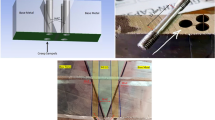In this study, the influence of the parameters of welding thermal cycles on the structure formation and changes in the hardness of the metal of a heat-affected zone (HAZ) of welded joints from high-strength steels for pipes with increased deformation ability was examined. Findings reveal that the metal of the HAZ of welded joints made of pipe steels with increased deformability can be subjected to softening up to 20%–24% during the welding process. The structure and phase composition of the metal of the lowtemperature section of the thermal impact zone was determined, and the findings guarantee its equal strength with the base metal. A range of cooling speeds was established, which eliminate the metal softening in the HAZ of welded joints.






Similar content being viewed by others
References
I. Yu. Pyshmintsev et al., “Mastering the production of large-diameter pipes with increased deformation capacity,” Vest. YUUrGU. Ser. Metallurgiya, 16, No. 1, 82–90 (2016).
I. P. Shabalov, S. Yu. Nastich, and V. Ya. Velikodnev, “Mechanical properties of large-diameter pipes with increased deformation capacity (for Asia-Pacific Region zones),” Metallurg, No. 9, 52–59 (2017).
N. Ishikawa, M. Okatsu, and D. Kondo, “Development of high-strength pipes for main pipelines designed for operation in severe geological and climatic conditions,” Nauka Tekhnika Gaz. Promyshl., No. 1, 92–99 (2009).
M. Yu. Matrosov, I. V. Lyasotsky, A. A. Kichkina, D. L. Dyakonov, and A. A. Efimov, “Aspects and classification of structures of low-carbon low-alloy high-strength pipe steels,” Stal’, No. 1, 65–74 (2012).
Yu. D. Morozov, A. M. Korchagin, V. V. Orlov, A. A. Stepanov, E. I. Khlusova, and S. Yu. Nastich, “Structure and properties of a strip for large-diameter pipes made of steel of strength categories X80–X100,” Metallurg, No. 3, 43–49 (2009).
M. Yu. Matrosov, L. I. Efron, A. A. Kichkina, and I. V. Lyasotsky, “Investigation of the microstructure by steel microalloying with niobium after various modes of controlled rolling with accelerated cooling,” MiTOM, No. 3, 44–49 (2008).
S. S. Babu and H. K. D. H. Bhadeshia, “Mechanism of the transition from bainite to acicular ferrite,” Mater. Trans. JIM, 32, No. 8, 679–688 (1991).
I. A. Yakubtsov and J. D. Boyd, “Bainite transformation during continuous cooling of low carbon microalloyed steel,” Mater. Sci. Technol., 17, No. 3, 296–301 (2001).
L. A. Efimenko, A. A. Ramus’, and A. O. Merkulova, “Peculiarities of austenite decomposition in the heat-affected zone during welding of high-strength steels,” FMM, 116, No. 5, 1–10 (2015).
L. A. Efimenko and A. A. Ramus’, “Influence of structure morphology on brittle fracture resistance of welded joints of highstrength pipe steels,” MiTOM, No. 9 (723), 41–45 (2015).
L. A. Efimenko, O. E. Kapustin, I. Yu. Utkin, A. A. Ramus’, D. V. Ponomarenko, S. P. Sevostyanov, and R. O. Ramus’, “Evaluation of the structure and properties of repair welded joints of gas pipelines from steels with increased deformability,” Svaroch. Proizvod., No. 12, 40–46 (2019).
L. A. Efimenko, D. V. Ponomarenko, I. Yu. Utkin, and R. O. Ramus’, “Investigation of the effect of austenite grain growth tendency on the HAZ impact strength of welded joints of low-carbon low-alloy steels,” Metallurg, No. 9, 24–28 (2020).
L. A. Efimenko, O. E. Kapustin, I. Yu. Utkin, D. V. Ponomarenko, S. P. Sevostyanov, and R. O. Ramus’, “Evaluation of weldability of steels with increased deformation capacity as a means of substantiating repair technologies,” Nauka Tekhnika Gaz. Promyshl., No. 4 (84), 74–83 (2020).
Instructions for Welding of MG Bovanenkovo — Ukhta with Working Pressure up to 11.8 MPa. Part I. Basic Requirements, Welding Technologies, and Quality Control of Welded Joints (Approved by the Deputy Chairman of the Gazprom Management Committee on 07/01/2008), OOO Gazprom Expo, Moscow (2008).
Technical Requirements for Pipes of Experimental Batches for Sections of Main Gas Pipelines for Operating Pressure up to 9.8 MPa (100 kgf/cm 2 ) Inclusive, Crossing Zones of Active Tectonic Faults, OOO Nauchno-Issledovatel’skiy Institut Prirodnykh Gazov i Gazovykh Tekhnologiy (OOO Gazprom VNIIGAZ) (2013).
Author information
Authors and Affiliations
Corresponding author
Additional information
Translated from Metallurg, Vol. 66, No. 7, pp. 58–63, July, 2022. Russian DOI: https://doi.org/10.52351/00260827_2022_07_58.
Rights and permissions
Springer Nature or its licensor (e.g. a society or other partner) holds exclusive rights to this article under a publishing agreement with the author(s) or other rightsholder(s); author self-archiving of the accepted manuscript version of this article is solely governed by the terms of such publishing agreement and applicable law.
About this article
Cite this article
Efimenko, L.A., Kapustin, O.E., Ramus’, A.A. et al. Aspects of Changing the Structure and Hardness of Metal of Heat-Affected Zone During Welding of Low-Carbon High-Strength Steels for Pipes with Increased Deformability. Metallurgist 66, 805–814 (2022). https://doi.org/10.1007/s11015-022-01391-2
Received:
Revised:
Accepted:
Published:
Issue Date:
DOI: https://doi.org/10.1007/s11015-022-01391-2




